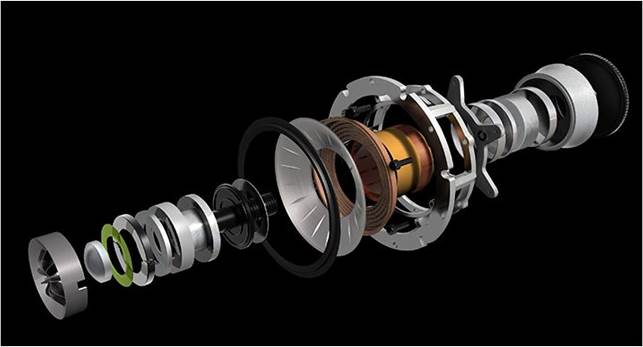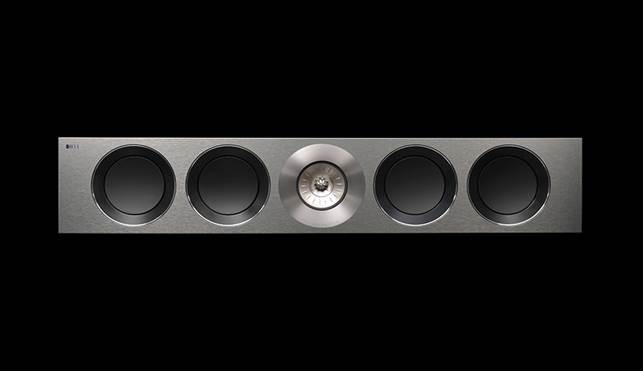Disappearing act
If daunted by the size and weight of the packing boxes I
must say that, once set up, the Reference 5s had a pleasing and thoroughly
harmonious look: their slim frontal aspect means that they don't unduly
dominate the room.
You might find it hard to believe that a speaker of this
size can ‘disappear', sonically. But it does, creating a soundstage
effortlessly disengaged from the boxes that are producing it.
This was obvious from the first disc that I played, which
was Mitsuko Uchida with Debussy's 12 Études [Philips 422 412-2]. Here the
bottom-end sound of the Reference 5 gave a striking and realistic weight to the
lower registers of the piano. It seemed you could hear not just the strings vibrating,
but the whole frame of the piano. This substantial instrument just had a very
palpable and lifelike presence.
Beyond that, though, the KEF Reference 5s also passed the
acid test of this demanding recording by being totally unfazed by the effect of
the reverberant acoustic when the music gets fast, high and loud. For once
there was really no sense of unpleasant confusion.

Above is Latest
Uni-Q driver. Along with the tweeter surround and the mid cone itself, the
segmented ‘tangerine’ in front of the tweeter forms a sophisticated waveguide
system
On vocal tracks too, the Reference 5s seemed to get of the
way completely and let the singer's performance become as intimate and
heartrending as you could wish. With Katia Guerreiro and Fado [Milan 399
269-2], the distinctive ringing sounds of the Portuguese guitar also became
something special, with a wonderfully springy and immediate quality. And again,
a recording that can often sound too bright and hard became simply inviting,
very well detailed, with plenty of attack and life, but free of hard edges.
It didn't take long to tune in to the difference between
KEF's two alternative bass ports in my particular room conditions, with the
speakers around 0.8m from the back wall. First I listened to the double-bass intro
on ‘Easy Money' from Rickie Lee Jones [Warner 256 628]. With the long port
lining as supplied, the bass was very good, even and uncoloured and in good
proportion. But switching to the shorter port brought a real benefit in some
ways, with the double-bass sound now feeling richer and warmer, with a
seemingly more free or open quality.

With the long port
lining as supplied, the bass was very good, even and uncoloured and in good
proportion
With Adele's ‘Rolling In The Deep' [21, XLCD 520], switching
to the shorter ports made the big bass-drum sound really come to life - truly
gut-wrenching. Finally, when I put on the great Eddy Louiss track ‘Blues For
Klook' from Sang Mele [Nocturne NTCD 101], using the short ports the
subterranean keyboard bass was a killer, sounding big, warm and hypnotic.
Open midrange
On other tracks, with either port tuning, I couldn't help
but be impressed by the combination of clarity and power at the bottom end, but
it was ultimately the very pure and open sound in the midrange that kept me
listening. I put on Boz Scaggs’ Greatest Hits Live [Gray Cat GCD 4001] and soon
found myself grooving as Scaggs' big-sounding band got going on tracks like
‘Lido Shuffle'.
Here, the Reference 5 really brought out the way every band
member contributes to the arrangement as Scaggs gave out on his most successful
song, ‘We're All Alone'. His unique vocal style came over even more poignantly
on the regretful, bluesy ‘Somebody Loan Me a Dime'. On this recording, which is
almost too carefully crafted to be thought of as live, the KEF speakers once
again did their disappearing act, and left behind a great big soundstage that
welcomed you into the music.

The soundstage was
disengaged from the boxes producing it
To give the KEFs something to bite on, I played Florence And
The Machine's ‘Dog Days Are Over' [Lungs, Island/Moshi Moshi 2709059], and
loved the way everything stayed intelligible right through to the climactic
ending. With track 2, ‘Rabbit', it seemed the sheer transparency of the KEFs
was excellent at revealing the producer's musical intentions and yet at the
same time it also clearly told you about the grunginess of the electronics in
the recording chain!
Turning to the natural vocal sound of Luke Pritchard on
‘Seaside, from The Kooks' Inside In/Inside Out [Virgin 0094635072426] the
Reference 5 delivered a really up- close-and-personal view, portraying his
breath noises so vividly that you could almost see his facial expression. After
this, ‘Eddie's Gun' was even more of a shock than usual, as its post-Punk
guitar was really ear-shredding.
Shimmering sounds
By way of contrast, I put on some Archiv recordings of Bach
violin concertos, with Trevor Pinnock's The English Concert [463 725-2]. Here
the KEFs put forth the lively sound of the disc, giving a realistic impression
of the hall ambience along with impeccable clarity and singing string tones.
The attack of the violins sounded just right, with lower strings full-bodied
and woody.
Returning to the more processed sounds of pop, the Reference
5 could give you a bright, upfront sound that shimmered between the speakers,
but never got too sharp or edgy. Picking tracks off KEF's own 50th anniversary
compilation CD, I lighted on The Cranberries' ‘Dreams' from 1992, which the
KEF's turned into an admirable confection of plinging guitars, throbbing bass
and bass drum, with Dolores O'Riordan's vocal like a slightly tangy topping. It
was sweet.

KEF Reference 2014
models
|
Specifications
·
Sensitivity (SPL/1m/2.83Vrms - Mean/IEC/Music):
88.7dB/89.1dB/89.1dB
·
Impedance modulus min/max (20Hz-20kHz) : 3.1ohm @
33Hz 13.3ohm @ 2.4kHz
·
Impedance phase min/max (20Hz-20kHz): -31o @ 4.4kHz
37o @ 1.3kHz
·
Pair matching (400Hz-20kHz): ±1.5dB
·
LF/HF extension (-6dB ref 150Hz/10kHz): 55Hz /
>40kHz/>40kHz
·
THD 100Hz/1kHz/10kHz (for 90dB SPL/1m) : 0.3% / 0.1%
/ 0.1%
·
Dimensions (HWD): 1350x205x470mm
|